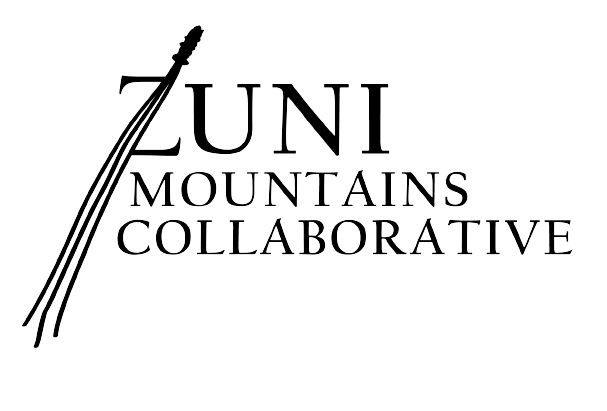By Juan Lemos, Marking Crew Lead and Coordinator, Forest Stewards Guild
Several years ago, the Cibola National Forest saw an opportunity to leverage partnerships to increase the pace and scale of forest restoration (i.e., treat more acres, faster) using ecologically based forest thinning. They tapped the Zuni Mountains Collaborative to bring personnel from partner organizations onto the landscape to prepare planned treatment units prior to thinning.
Starting in the summer of 2021, the Mt. Taylor Ranger District the Forest Stewards Guild formed an agreement supporting a small Timber Marking Crew. The crew, funded by the Zuni Mountains CFLRP and hired by the Guild, works under the supervision of experienced Forest Service forestry technicians and is comprised of people with varying levels of experience and diverse backgrounds. For 6-10 weeks in the fall, they mark timber in units selected for future thinning and inspect trees to establish baseline forest conditions in areas that the Forest Service is considering for treatment.
Before the forest can be thinned, units - or distinct areas with delineated geographic boundaries - must first be identified and laid out on a map according to stand type, existing road systems, District priorities, and accessibility. After they have been planned, these units must be ground-truthed (the boundaries walked with a GPS), evaluated for vulnerable features that need to be avoided such as streams or heritage sites, and the trees marked with paint to either be cut or left according to a forest treatment plan called a silvicultural prescription provided by a certified silviculturist.
Forest prescriptions provide the marking crew with vital information about the areas where they are working.
Some items in the prescription are easy to understand: the location, unit identifier, project, and acreage. Others require training: the desired species composition and spatial arrangement of groups of trees that will be left after thinning, and the desired stocking guidelines such as target Basal Area (BA) and VSS tree class (sizes of trees). The prescription builds in heterogeneity, or forest diversity, by specifying that trees left on the landscape should vary in size, age, and species, should be left in clumps with spaces in between, and should make space for different types of habitats such as oak stands and meadows. These instructions, when interpreted correctly by the marking crew and followed by the sawyers, result in a forest which is more resilient to fire, pests, disease, and other disturbances.
Marking crews shape the future forest by directing logging crews what to cut and where.
Different colors of marking paint are used by the crew to guide the sawyers: orange paint means “leave” or “do not cut” the tree; blue paint means “cut” or remove the tree; and black or turquoise paint are used to fix mistakes. A silvicultural prescription, while allowing for diversity in the forest, will generally instruct the marking crew to leave the healthiest and largest trees on the landscape and to mark those with signs of disease, such as mistletoe outbreaks, to be cut. Before marking each tree, crew members will measure its size and evaluate it from the ground, looking for signs of disease or pests, structural defects (genetic or from damage), and other markers of health. Sometimes clumps of trees are marked to be cut to “daylight” oak stands (a rich habitat for wildlife) which promotes growth, reduces fuel, and provides space in congested areas. Certain trees will get a special mark designating them as wildlife trees or future snags. Colorful flagging, tied to tree limbs and shrubs around the perimeter of thinning units and along vulnerable areas, is used to tell sawyers where they should be cutting and where they shouldn’t go.
The trees that are cut are hauled from the forest to be utilized either by the local mill as lumber, animal bedding, molding, or fire pellets, or by surrounding communities as fuelwood. Removing the trees from the area where they were cut reduces the amount of combustible woody material - both live standing trees and dead dry wood and needles on the ground - that could contribute to high severity, high mortality fires that threaten homes and businesses.
Forest thinning in ponderosa pine forests readies them for the reintegration of lower-severity beneficial fire, a natural element in the landscape.
In 2023, the collaborative marking crew prepared over 200 acres near McGaffey Lake and helped to re-mark a large area (554 acres) whose target tree density (BA) needed to be increased due to the presence of goshawks. Whether encountering a momma bear and her two cubs, finding a geocache, or simply hiking the gentle contours of the Zuni Mountains for miles and miles, every day with the marking crew is an adventure. Crew members look forward to returning to the forests of the Zuni Mountains each season.







